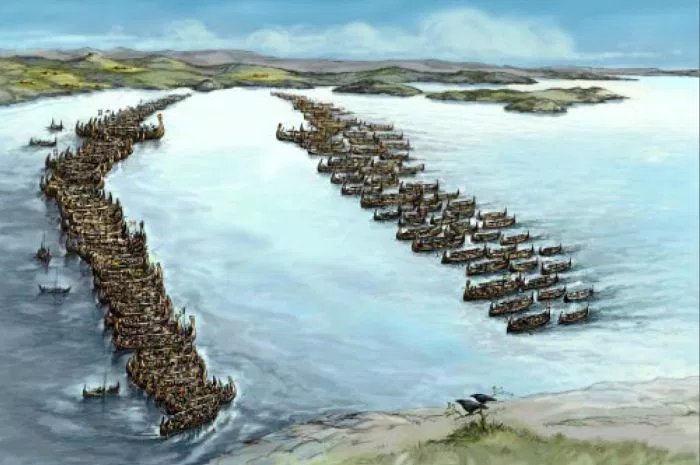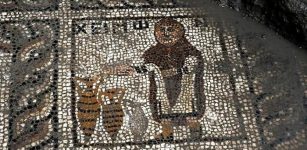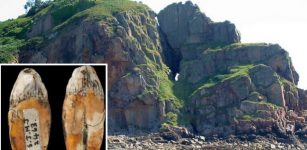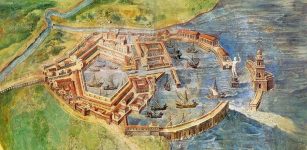Sverd I Fjell – Swords In Rock: Battle Of Hafrsfjord Won By Harald Fairhair – First King Of Norway
A. Sutherland - AncientPages.com - Three huge Viking swords tower over Hafrsfjord just outside Stavanger, Norway. This extraordinary artwork - Sverd I Fjell (Swords in Rock) was created to commemorate Norway's unification as a single kingdom in 872.
The three swords are more than just a tourist attraction. The monument is of great historical importance. The memorial was made by Friz Røed (1928-2002) and unveiled by King Olav in 1983.
Sverd i Fjell – Stavanger's impressive Viking monument. Image source.
It commemorates the Battle of Hafrsfjord in 872. It was at this place that Harald Fairhair (Norwegian: Harald Hårfagre) fought a battle that united Norway into one kingdom in 872 AD.
King Harald Fairhair - First King Of Norway
Harald Fairhair reigned from c. 872 to 930 and is today recognized as the first King of Norway.
Little is known about this royal personality. Although Harald's life is described in several of the Kings' sagas, they were written around three centuries after his lifetime. The lack of existing sources makes it very difficult to reconstruct his life.
The accounts of Harald and his life differ on many points, and some of the content may be uncertain. However, it is clear that in the 12th and 13th centuries, Harald played a crucial role
 Harald Fairhair, in an illustration from the 14th century Flateyjarbók. Image credit: Tokle - Public Domain
Harald Fairhair, in an illustration from the 14th century Flateyjarbók. Image credit: Tokle - Public Domain
In the early Middle Ages, Norway was divided into many small kingships. According to the sagas, Harald Fairhair (ca. 865 – ca. 933) united Norway into a single kingdom and played a crucial role in this political process.
The Battle of Hafrsfjord, which supposedly took place in about 885, is regarded as decisive in the unification of Western Norway. The battle is described in the Saga of Harald Fairhair in Snorri's Heimskringla.
According to Snorri's saga, King Harald Fairhair defeated several kings, but even before the battle, he controlled large parts of southeast Norway.
Other sources claim that the eastern part of Norway was under the Danish king. The Battle of Hafrsfjord marks the final crushing of opposition from Norway's southwestern portion.
 The The naval battle in Hafrsfjord in about 872 AD is one of the largest in the history of Norway (Photo: Sola Historielag)
The The naval battle in Hafrsfjord in about 872 AD is one of the largest in the history of Norway (Photo: Sola Historielag)
It made it possible for King Harald to subdue the country and collect taxes from a large part of it. Many defeated who would not submit to Harald's rule emigrated to Iceland.
Winning the Battle of Hafrsfjord resulted in King Harald I of Norway's declaration to become the sole ruler of Norway. This battle may have been the largest in Norway up to that time and for a good while afterward.
The King's sons, Eric Bloodaxe and Haakon the Good, succeeded Harald in becoming kings after his death.
When we look at the three swords in the rock, we should not forget that they represent peace, unity, and freedom.
Written by – A. Sutherland - AncientPages.com Senior Staff Writer
Copyright © AncientPages.com All rights reserved. This material may not be published, broadcast, rewritten or redistributed in whole or part without the express written permission of AncientPages.com
Expand for referencesReferences:
Thor News - Searching for Traces of the Battle of Hafrsfjord – 872 AD
The Stavanger Region – Swords in Rock
Heimskringla, The Chronicle of the Kings of Norway
More From Ancient Pages
-
 Walls Of Uruk Built By Sumerian King Gilgamesh 4,500 Years Ago
Featured Stories | Nov 28, 2015
Walls Of Uruk Built By Sumerian King Gilgamesh 4,500 Years Ago
Featured Stories | Nov 28, 2015 -
 Ancient Mosaics Dated To The First Century Discovered In Southern Turkey
Archaeology | Jan 14, 2019
Ancient Mosaics Dated To The First Century Discovered In Southern Turkey
Archaeology | Jan 14, 2019 -
 Legend Of Milky Way’s Celestial Portal And The Star City From The Bowuzhi By Zhang Hua
Chinese Mythology | Feb 14, 2024
Legend Of Milky Way’s Celestial Portal And The Star City From The Bowuzhi By Zhang Hua
Chinese Mythology | Feb 14, 2024 -
 Colossi Of Memnon Guarded Temple Of Pharaoh Amenhotep III And Curious Sound Phenomenon
Featured Stories | Feb 2, 2021
Colossi Of Memnon Guarded Temple Of Pharaoh Amenhotep III And Curious Sound Phenomenon
Featured Stories | Feb 2, 2021 -
 On This Day In History: Sunspot Observed By Chinese Astronomers During The Han Dynasty – On May 10, 28 BC
News | May 10, 2016
On This Day In History: Sunspot Observed By Chinese Astronomers During The Han Dynasty – On May 10, 28 BC
News | May 10, 2016 -
 Pena Molexa (Lunar Boat): Megalithic Corner Dedicated To A Magician Woman Who Knows The Secrets Of Earth And Underworld
Featured Stories | Jul 23, 2023
Pena Molexa (Lunar Boat): Megalithic Corner Dedicated To A Magician Woman Who Knows The Secrets Of Earth And Underworld
Featured Stories | Jul 23, 2023 -
 Early Human Settlement Unearthed In Tajikistan’s Zeravshan Valley Gives New Insights Into Human Expansion
Archaeology | Nov 5, 2024
Early Human Settlement Unearthed In Tajikistan’s Zeravshan Valley Gives New Insights Into Human Expansion
Archaeology | Nov 5, 2024 -
 Ancient Dragon Stone That Inspired Legends Discovered In Turkey
Archaeology | Dec 12, 2018
Ancient Dragon Stone That Inspired Legends Discovered In Turkey
Archaeology | Dec 12, 2018 -
 Timboholm Great Golden Treasure Dated To Iron Age’s Great Migration Period
Artifacts | Oct 19, 2018
Timboholm Great Golden Treasure Dated To Iron Age’s Great Migration Period
Artifacts | Oct 19, 2018 -
 Sybil Ludington: Courageous American Girl Who Rode For Independence
Featured Stories | Dec 19, 2020
Sybil Ludington: Courageous American Girl Who Rode For Independence
Featured Stories | Dec 19, 2020 -
 On This Day In History: Treaty Of Picquigny – Negotiations Between England And France – On Aug 29, 1475
News | Aug 29, 2017
On This Day In History: Treaty Of Picquigny – Negotiations Between England And France – On Aug 29, 1475
News | Aug 29, 2017 -
 Did The Viking Blood Eagle Ritual Ever Happen Or Was It A Misunderstood Story?
Archaeology | Dec 21, 2021
Did The Viking Blood Eagle Ritual Ever Happen Or Was It A Misunderstood Story?
Archaeology | Dec 21, 2021 -
 Stone Water Well Dated To Sassanid Era (224-651 CE) Unearthed In Isfahan Hills, Iran
Archaeology | Jun 26, 2020
Stone Water Well Dated To Sassanid Era (224-651 CE) Unearthed In Isfahan Hills, Iran
Archaeology | Jun 26, 2020 -
 Extremely Rare English Medieval Shipwreck With Fascinating Cargo Discovered In Poole Bay, Dorset
Archaeology | Jul 23, 2022
Extremely Rare English Medieval Shipwreck With Fascinating Cargo Discovered In Poole Bay, Dorset
Archaeology | Jul 23, 2022 -
 Evidence Of A Hybrid Population Of Neanderthals And Modern Humans Discovered At La Cotte De St Brelade
Archaeology | Feb 9, 2021
Evidence Of A Hybrid Population Of Neanderthals And Modern Humans Discovered At La Cotte De St Brelade
Archaeology | Feb 9, 2021 -
 Exceptional Discovery Of Ancient Fresco Depicting Mythological Scenes In Peru
Archaeology | Dec 1, 2022
Exceptional Discovery Of Ancient Fresco Depicting Mythological Scenes In Peru
Archaeology | Dec 1, 2022 -
 World’s Oldest Hand Stencils Were Made By Neanderthals In The Maltravieso Cave 66,000 Years Ago
Archaeology | Dec 9, 2024
World’s Oldest Hand Stencils Were Made By Neanderthals In The Maltravieso Cave 66,000 Years Ago
Archaeology | Dec 9, 2024 -
 Mystery Of Biblical Adam – A Hidden Story Within A Story Open To Interpretation
Ancient Mysteries | Jan 18, 2018
Mystery Of Biblical Adam – A Hidden Story Within A Story Open To Interpretation
Ancient Mysteries | Jan 18, 2018 -
 Scientists Caution Against Over-Interpreting Influence Of Climate On Cultural Change And Catastrophe
Archaeology | Aug 18, 2022
Scientists Caution Against Over-Interpreting Influence Of Climate On Cultural Change And Catastrophe
Archaeology | Aug 18, 2022 -
 Portus: History Of Ancient Roman Hub Of Commerce – Reconstructed With New Methods
Archaeology | Jul 17, 2019
Portus: History Of Ancient Roman Hub Of Commerce – Reconstructed With New Methods
Archaeology | Jul 17, 2019

